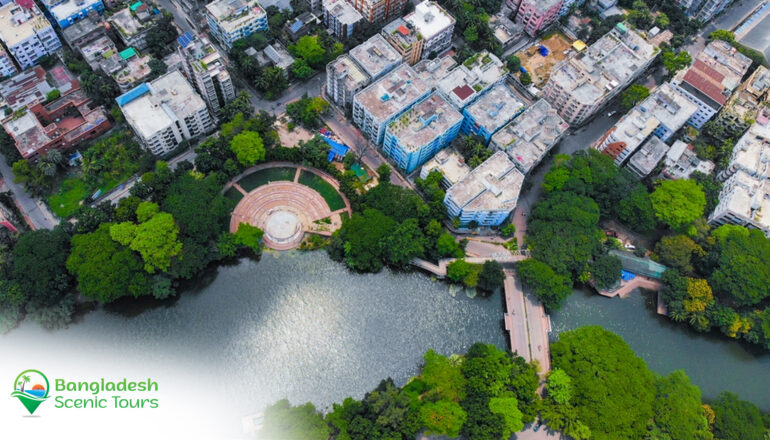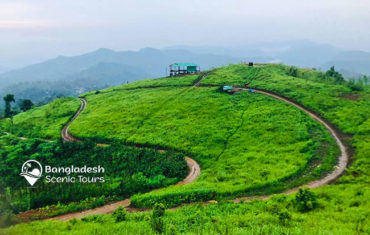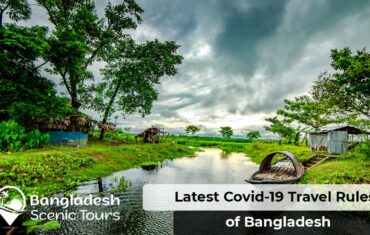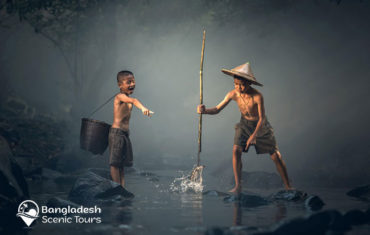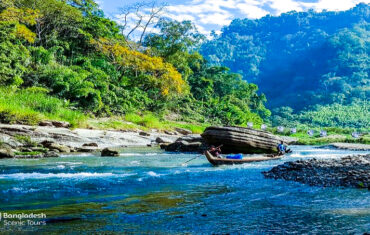Imagine that you are traveling to Bangladesh and that you have chosen to stay in Dhaka, the nation’s capital. You have no notion what to do in Dhaka with the time that you have available to you there. This may be an intimidating and stressful experience for someone who is not familiar with a place and does not know what the greatest alternatives are for passing the time and what kinds of activities are likely to provide the most memorable moments. This article’s only purpose is to provide a solution to that specific issue.
Dhaka, the capital and largest city of Bangladesh, offers tourists a broad range of intriguing sights, sounds, and experiences to enjoy during their time there. The Muslim architecture of the country, which was crafted by Mughal greats such as Shaista Khan, is fascinating. It is complemented by contemporary developments such as shopping malls and amusement parks, as well as cultural events so that tourists can get a sense of both local culture and Islamic tradition. Not only the Islamic traditions, being one of the most diverse cultural societies Bangladesh has many cultural diversities which reflect in the cities of the country, and Dhaka being the most crowded city in Bangladesh, you’ll find a lot of interesting things to observe if you have the right guideline to explore the city.
Here are the things you can do while your time in Dhaka:
Explore the City
There are a number of exciting locations to explore in Dhaka, and some of them can pique your curiosity. The tour of a city is often more fascinating when one is familiar with its history; for this reason, you should begin your exploration of Dhaka by seeing some of the city’s culturally significant and historically significant locations. The following is a list of locations in Dhaka that you shouldn’t miss during your time in Dhaka:
1. Sonagaon
These ruins, which can be seen in close proximity to Dhaka, provide visitors a look into the Islamic history and culture that has shaped Bangladesh. The place, whose name translates to “Golden City” or “Golden Village,” is an excellent option for anybody who wants to view the countryside around Dhaka while also partaking in some archaeology and high adventure. Both mosques and the remnants of elegant mansions, such as Raj baris or other palatial constructions, that formerly belonged to rich rulers and proprietors may be found in this region. In addition to a wonderful museum that displays folk art from the surrounding area, the quaint small town also has a peaceful pond. This location is ideal for anybody who is interested in ruin tourism since it is evocative of India’s majestic forts and palaces and has scattered towns as well as ancient ruins.
2. Lalbagh Fort
The fort is a wonderful illustration of the Mughal or Muslim culture that once flourished in this nation. It is encircled by stunning gardens and offers a tranquil escape from the frenetic activity of the metropolis of Dhaka. The fort was constructed by Shaista Khan, who was the son of the Mughal emperor Aurangzeb. Within the fort is a monument for the architect’s daughter, Pari Bibi. In addition to housing a museum devoted to artifacts from the Mughal period, the fort also has both an amphitheater and a mosque. In addition to the regular selection of swords and weaponry, the fort has a standard Queen Bath, which includes both a bathhouse and a bathing tank.
3. Panam City
Panam City, which is located close to Sonargaon, has been abandoned since the middle ages. The city was a vibrant commercial center until its population fled it during the period of British colonial authority, at which point the city was abandoned by its residents. Guests visiting the city now have the chance to take in the city’s stunning architecture, and they are welcome to explore the remains of the city. Fans of history and architecture should not miss the opportunity to visit this city due to the intriguing blend of Hindu, Buddhist, and Islamic design elements that can be seen here.
4. Liberation War Museum
This museum honors the liberation struggle of Bangladesh and Bangladesh’s independence from Pakistan. It is quite similar to a war museum in Cambodia that concentrates on the genocide of ethnic minorities. The museum also functions as a cultural center, with a tea shop and book store in addition to exhibits and events that are related to the liberation of the country. It is important for the country’s rich cultural and political history to be passed down to future generations, so historical museums have received funding, relics, and exhibitions from countries outside of the country. Japan and the United States are two of the countries that have made these contributions. The museum of the liberation fight contends that Bangladesh is not East Pakistan but rather a distinct Muslim country of its own apart from East Pakistan.
5. Shahid Manar
The city of Dhaka is home to a number of cemeteries and memorial parks. This memorial was constructed in the year 1952 in remembrance of the many students and activists who lost their lives during protests that were connected to the language struggle. This building has emerged as a contentious issue in Dhaka. The gardens’ eye-catching hues have enticed visitors not only from all over the world but also from those who are merely passing through the area.
6. Pink Palace or Ahsan Manjil
One of the most popular places for visitors to go while in Dhaka is the Pink Palace, also known as Ahsan Manzil. This edifice, which can be found in Old Dhaka on the banks of the Buriganga River, was formerly the residence of one of Dhaka’s most influential families of feudal landlords back when the British governed the Indian subcontinent. The Buriganga River runs through Old Dhaka.
The Nawab family made their first property acquisition in the early 19th century, which was a small parcel of land. On this little piece of land, the Nawab family would eventually create this gigantic palace as their fortune expanded. The palace was allowed to deteriorate once the British were no longer in charge of it. The building was eventually acquired by the government of Bangladesh, which then undertook extensive renovations in order to prepare it for use as a museum. It is highly recommended that visitors visiting Bangladesh pay a visit to Ahsan Manzil.
7. Star Mosque or Tara Mosque
The Star Mosque can be found in Old Dhaka’s Armanitola area, around 350 meters to the north of the Armenian Church. The Old Dhaka Market is a popular destination for tourists in the city. The inside and outside of the mosque are both decorated with mosaics.
Mount Fuji patterns on glazed tiles adorn the outside wall in the space between the doors, and a crescent moon and star-like design adorn the front of the building towards its peak. Many blue stars, of all sizes and shapes, are painted on the marble domes. The mosque gets its name from the pervasive star motif seen throughout the building (Tara Masjid in Bengali).
8. Khan Mohammad Mridha Mosque
The Khan Mohammad Mridha Mosque may be found in Old Dhaka around 500 meters to the west of the Lalbagh Fort. As shown by two Persian inscriptions, one of which is located over the main archway and the other of which is located above the main Mihrab, it was most likely planned by a Khan Mohammad Mirza and built during the reign of Farrukh Siyar, who served as the Deputy Governor of Dhaka. In the years 1704 and 1705, a religious authority named Qazi Ibadullah gave the order to erect the edifice.
Lalbagh Fort and the Khan Mohammad Mridha Mosque both have some similar architectural characteristics. On a raised platform that is 5.8 meters above the ground, it stands there. Under the platform were vaulted rooms that served as storage and living quarters. These chambers were accessible from all sides of the platform with the exception of the east. On the eastern side of the mosque is a doorway that is aligned with the main entrance, and it may be accessed through a stairway of 25 steps. Through this entrance, it is possible to reach the highest point of the platform.
9. Armenian Church
Armanitola is a neighborhood in Old Dhaka that acquired its name from the sizable Armenian population who settled there before the end of the 17th century. The Armenian Church of the Holy Resurrection can be found in Armanitola. The local church acts as the epicenter of spiritual life in the community. This Dhaka landmark dates all the way back to 1781, making it an ideal destination for anyone seeking a tranquil haven in the middle of the hustle and bustle of the city.
10. Dhakeshwari Temple
The Dhakeshwari Temple is a Hindu temple that was built around 500 years ago by one Mangat Ray, also known as Ballalasena. Mangat Ray was the younger brother of the Arakan ruler Shri Sudharma, who was the son of the well-known Arakan king Raja Malhana alias Husen Shah. The state of Myanmar currently owns the Dhakeshwari Temple. This is the place where members of the Hindu community in Dhaka City get together to pray and celebrate their history. When they enter the temple, devotees dressed in colorful saris ring the bell and then proceed to execute a number of other rites. You can always bet on seeing a vibrant scene here in Dhaka since here is where the most important Hindu events in the city get their start. If you find yourself in Dhaka, you should make it a point to visit the Dhakeshwari Temple.
11. Curzon Hall
The residence of the Dhaka University Science School is Curzon Hall, which is located in Dhaka city and district. It was in commemoration of Lord Curzon, who served as Viceroy of India, that this hall was given its current name. 1904 was the year that saw the completion of the construction. Originally the location of Dhaka college, it subsequently became a component of the scientific division of the University of Dhaka after the city was selected as the capital of East Bengal and Assam after the partition of Bengal. This occurred when the city was declared as the capital of East Bengal and Assam.
This location is historically significant because in 1948 it was here that students from Dhaka University first voiced their opposition to the declaration made by Mohammad Ali Jinnah that Urdu alone would be the state language of the entirety of Pakistan. This action was the spark that ignited the Language Movement.
12. Parliament of Bangladesh
Louis I. Kahn, an American architect of international renown, is best known for his work on the Bangladesh Parliament Building. This structure is his crowning architectural achievement. Kahn is a professor of architecture at Yale University. During the time that Bangladesh was still known by its former name, East Pakistan, the Pakistani government commissioned the construction of this building. This took place during the Partition of the Indian Subcontinent. Its initial function was supposed to be that of a second capital for the country’s parliamentary government. The Bangladeshi War of Independence began in 1964 but ultimately delayed the construction of the building until 1982 when it was finally finished. If you’re interested in architecture, this is one of the two most important sites to visit in Dhaka.
13. Sadarghat the rivar station
The southern portion of Dhaka, along the Buriganga River near Sadarghat, is one of the city’s liveliest areas. One of the world’s biggest river ports may be found at the Sadarghat Launch Terminal. Every day, over 200 passenger launches, both big and small, leave and return to the station. Facility employees estimate that 30,000 passengers utilize the terminal each and every day. You could see things here that are impossible in the real world.
Even though it stinks and is nasty, the River Buriganga is the lifeline of Old Dhaka. The loading and unloading of passengers and local products at the dilapidated warehouses along the riverbank are intriguing to see. Small wooden boats stack their cargo in between the triple-decked ferries that are parked along the jetty. As boats leave and return from the countryside, the scream of the sirens sounds like an air strike.
14. Shakari Bazar
When people speak about visiting Old Dhaka, one of the first sites that springs to mind is Shakhari Bazar because of its relationship with the city’s craftsmen. A market area known as Shakhari Bazar can be found in Dhaka, Bangladesh. It is situated in a short road that is flanked by small strips of beautifully built brick houses that date back to either the early Mughal era or the colonial period. This neighborhood is just a few short streets away from the Buriganga, which is considered to be one of the most important thoroughfares in the ancient city. At the very least, the location of Shakhari Bazar dates back to the period of the early Mughals. When Mirza Nathan, a commander who later became a historian, traveled to Puran Dhaka with Subahdar Islam Khan, he made a record of the city in his chronicles for the very first time. If you’re seeking for a taste of traditional Dhaka, you should come here instead of anywhere else.
15. National Museum
The National Museum of Bangladesh is a fascinating destination that should not be missed by anyone interested in history, art and culture. Located in Shahbagh, Dhaka, the museum is renowned for its impressive collection of artifacts that offers a comprehensive insight into the country’s rich cultural heritage and history.
The exhibits are arranged across several galleries, with each section focusing on a different aspect of Bangladesh’s past and present. These exhibits also showcase the evolution of the Bengali language, literature and music.
Other things to do in Dhaka:
Experience some of Dhaka’s finest restaurants and dishes
The city of Dhaka is home to a large number of restaurants that provide an extensive range of cuisines. There are just a few establishments out of the many that are worthy of being singled out, despite the fact that exploring the area and finding new stores and restaurants is unquestionably an enjoyable activity.
To begin, you can’t say you’ve got the whole Dhaka experience until you’ve tried the local biryani. Long-standing eateries in the area, such as Nanna and Fakruddin, are known for serving some of the city’s most delicious biryani.
Their recipes from the time of the Mughals have been handed across generations for generations. There are a great number of restaurants in Bangladesh that serve biryani, but none of them can match Nanna and Fakruddin.
In 1947, a feudal lord also known as zamidar called the house that is now home to Beauty Boarding his permanent residence. After he left, a resident took over the lease for the property and turned it into a restaurant, which quickly became a gathering place for a variety of creative types as well as authors and politicians. You are more than welcome to stay at Beauty Boarding for lunch or dinner, and doing so is strongly encouraged.
Beauty A dessert and beverage establishment that also provides a one-of-a-kind eating experience is called Lassi and Faluda. If you find yourself in Old Dhaka, you really have to make a pit stop at this establishment to cool yourself with a cup of faluda or lassi.
When it comes to the cuisine of Dhaka city, going to Hotel Al-Razzak for a meal has developed into something of a tradition for many people. During the month of ramadhan, it is crawling with people who wake up at four in the morning to break their fast with their family and friends at a meal that is known as Suhoor. During this time, the area is teeming with activity. You are obligated to eat at the hotel due to the hotel’s upscale cuisine as well as its wonderful and creative meals.
Shop at the markets of Dhaka
The New Market is widely considered to be the premier shopping destination in all of Dhaka. You shouldn’t miss New Market if you’re seeking for a market in the city; it’s the best one around. The triangular shape of the market is interesting when seen from above, and the market’s architectural beauty is shown by the fact that it spans 35 acres of Dhaka’s real estate. The city’s elderly continue to frequent New Market in huge numbers despite the fact that tourists and younger Bangladeshis like the glitz of the new malls in wealthier neighborhoods such as Gulshan and Bashundhara.
This bazaar is a dream come true for those who are skilled in bartering. You are able to get whatever you need for your home, from the most basic items to the most sophisticated decorations. The activity, colors, and sounds of the market, in addition to its liveliness, have an allure that is impossible to resist.
Many visitors visit the market because it is known for selling leather goods and bags at costs that are far cheaper than those found in the rest of the city. Because it is teeming with both high-quality and low-quality knockoffs of major brands that are offered for a fraction of their original pricing, New Market is a shopper’s dream for those who like hunting for deals.
Take a Boat ride in the Buriganaga River
Taking a trip on the water is almost always an exciting and fascinating experience for anybody. In spite of the craziness that surrounds you in the form of the bustling metropolis and the busiest port in Dhaka, taking a boat trip on the Buriganga river may assist to bring some peace and quiet to your mind. If you are a photographer, you may capture images from the center of the river, the whole crowded Sadarghat, and the busy bankside of the old Dhaka. These views will blow your mind.
Take a rickshaw ride
It’s possible that you’ll have a once-in-a-lifetime experience if you take a rickshaw through the most crowded part of Dhaka. You are in for a number of pleasant surprises when you visit the busiest city in Bangladesh. The streets of Bangladesh are a great place to see the untamed elegance of Bangladeshi culture. As a result, taking a ride on a rickshaw in the heart of Dhaka city could provide you with some interesting new perspectives on the culture of the city. If you take a rickshaw ride in old Dhaka, you can get a sense of the city’s bygone era, but if you take a rickshaw ride in the Gulshan-Banani neighborhood of modern Dhaka, you might get a sense of how the city is evolving today. Rickshaw rides in Dhaka may take you to a variety of neighborhoods, each of which has its own personality and can provide you with a fresh perspective on the city.

